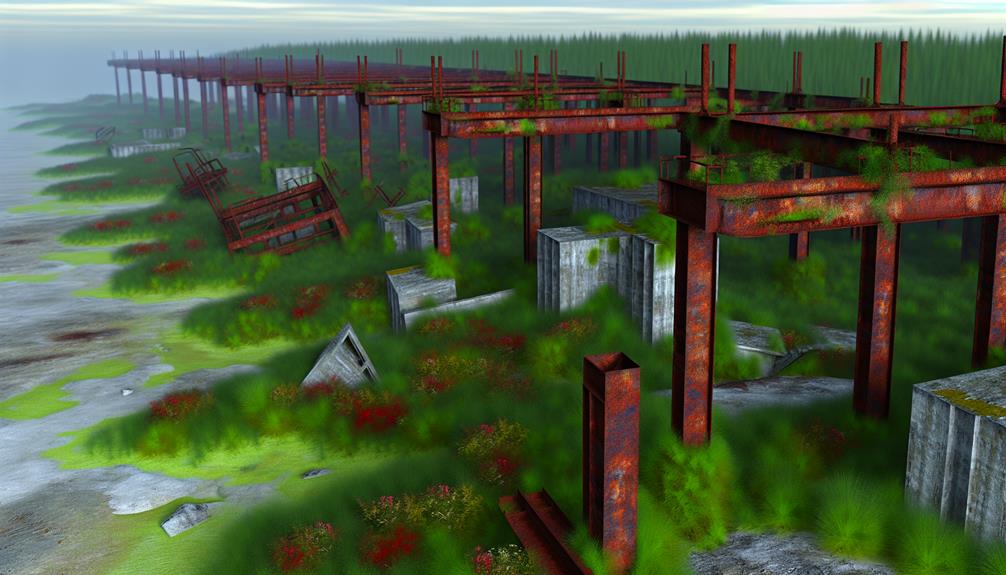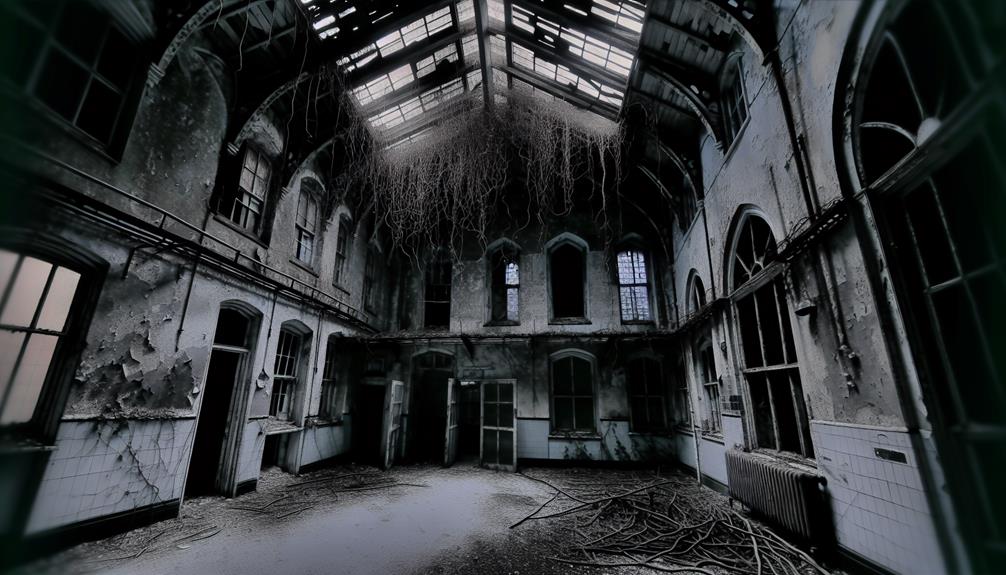The remnants of the 2011 Fukushima nuclear disaster stand as a somber reminder of the intersection between human technological prowess and the unpredictability of nature's forces. As visitors step onto the grounds of this historically significant site, a complex tapestry of narratives emerges – one that intertwines sorrow with strength, fear with hope. The journey through Fukushima's scarred landscape reveals layers of resilience and community spirit that challenge conventional perceptions of catastrophe. Each footstep echoes not only the past but also beckons contemplation towards a future shaped by the enduring legacy of Fukushima.
Key Takeaways
- Visitors must adhere to radiation protection protocols and wear protective gear.
- Designated pathways guide visitors through lower radiation areas for safety.
- Trained guides, radiation monitoring, and decontamination procedures ensure visitor safety.
- Emotional impact may be profound due to the site's tragic history.
- Community solidarity and support aid in coping and rebuilding efforts.
Historical Background of Fukushima Disaster
In March 2011, the Fukushima Daiichi nuclear power plant in Japan experienced a catastrophic triple meltdown following a powerful earthquake and tsunami. The causes of this unprecedented disaster can be traced back to the Tohoku earthquake, a magnitude 9.0 seismic event that struck off the coast of Japan. The earthquake triggered a massive tsunami, which inundated the Fukushima Daiichi plant, leading to the failure of the cooling systems necessary to keep the reactors from overheating. As a result, three of the plant's six reactors suffered meltdowns, releasing a significant amount of radioactive material into the environment.
The aftermath of the Fukushima disaster was profound, with widespread environmental contamination and the displacement of tens of thousands of residents from the surrounding area. The release of radioactive materials not only affected the immediate vicinity but also had far-reaching consequences, including impacts on the food chain and marine life. The cleanup and decommissioning efforts at the Fukushima Daiichi plant have been ongoing since the disaster, presenting significant technical challenges and requiring innovative solutions to mitigate further environmental contamination.
Impact on Environment and Communities
Following the Fukushima disaster, the environmental and societal repercussions have been significant, necessitating a thorough examination of the impact on communities in the vicinity. The aftermath of the nuclear disaster has left a lasting mark on the environment, necessitating extensive efforts in environmental restoration. The contamination of soil, water, and air has posed challenges for the region, requiring meticulous cleanup procedures to mitigate long-term consequences.
In addition to the environmental impact, communities surrounding the Fukushima Daiichi nuclear plant have faced immense challenges in the wake of the disaster. The displacement of residents, disruption of livelihoods, and psychological toll have necessitated a holistic approach to community rebuilding. Social support systems, economic revitalization initiatives, and mental health services have been pivotal in aiding the affected communities in their recovery process.
Efforts towards environmental restoration and community rebuilding have been ongoing since the disaster. Various stakeholders, including government agencies, non-profit organizations, and local community members, have collaborated to address the multifaceted challenges posed by the Fukushima incident. While progress has been made, the road to full recovery remains long and arduous. Continued support and sustainable initiatives are essential to safeguard the well-being of both the environment and the communities affected by the Fukushima nuclear disaster.
Current State of Fukushima Site
The ongoing assessment of the Fukushima site reveals the current status of environmental remediation efforts and structural integrity post-nuclear disaster. Significant progress has been made in the site cleanup, with extensive decontamination efforts aimed at reducing radiation levels and restoring the affected areas. Various techniques such as soil removal, water treatment, and vegetation control have been employed to mitigate the spread of radioactive materials and minimize environmental impact.
Radiation levels within the Fukushima site have been continuously monitored to guarantee the safety of workers and the surrounding communities. Advanced technologies like drones, robots, and remote sensing devices are utilized to assess radiation hotspots and identify areas that require further decontamination. The data collected from these monitoring activities is essential for evaluating the effectiveness of remediation efforts and informing future cleanup strategies.
Structural integrity assessments of the Fukushima site have been conducted regularly to evaluate the stability of buildings, reactors, and other infrastructure. Specialized teams of engineers and experts inspect the containment structures, reactor vessels, and storage facilities to detect any signs of deterioration or potential hazards. By ensuring the structural soundness of the site, the risk of further environmental contamination or safety incidents is minimized, providing a more secure environment for ongoing cleanup operations and future redevelopment plans.
Safety Measures for Visitors
Guaranteeing the safety of visitors to the Fukushima site involves strict adherence to established radiation protection protocols and controlled access measures. Radiation protection is paramount in safeguarding visitors against potential health risks resulting from exposure to radioactive materials. Visitors are required to comply with specific guidelines to minimize their radiation exposure and ensure their well-being.
Visitor guidelines encompass a range of safety measures aimed at reducing radiation exposure. Prior to entering the Fukushima site, visitors must undergo thorough radiation screening to assess their current exposure levels. Protective gear, such as full-body suits, masks, and gloves, is mandatory to minimize direct contact with radioactive contaminants. Additionally, designated pathways are marked to guide visitors through areas with lower radiation levels, reducing the risk of unnecessary exposure.
Controlled access measures limit the areas visitors can explore within the Fukushima site. High-risk zones with elevated radiation levels are strictly off-limits to guarantee visitor safety. Trained guides accompany visitors to provide information on radiation safety and to monitor adherence to safety protocols. Regular radiation monitoring and decontamination procedures further contribute to maintaining a safe environment for visitors.
Emotional Impact on Visitors
Amidst the controlled access measures and strict safety protocols at the Fukushima site, visitors may experience a range of emotional responses influenced by the legacy of the 2011 nuclear disaster. The psychological impact of standing in a place marked by such a catastrophic event can be profound, triggering a mix of emotions as individuals grapple with the enormity of the tragedy. For many, the journey to Fukushima becomes a part of their healing process, allowing them to confront their fears and uncertainties while seeking a sense of closure.
| Emotional Responses | Influences | Coping Mechanisms |
|---|---|---|
| Overwhelmed | Legacy of Disaster | Seeking Support |
| Sadness | Personal Reflections | Engaging in Rituals |
| Anxiety | Reminders of Loss | Sharing Experiences |
| Hopelessness | Survivors' Stories | Connecting with Nature |
Personal reflections often play an important role in this emotional journey, prompting visitors to contemplate their own mortality and the fragility of human existence. Coping mechanisms vary, with some finding solace in the stories of survivors, while others seek comfort in the natural surroundings of Fukushima. Ultimately, the emotional impact on visitors underscores the resilience of the human spirit in the face of adversity, highlighting the importance of acknowledging and processing difficult emotions as part of the healing process.
Resilience and Recovery Efforts
Following the emotional journey experienced by visitors to Fukushima in the aftermath of the 2011 nuclear disaster, the focus now shifts towards examining the resilience demonstrated and the ongoing recovery efforts in the region. In the face of adversity, Fukushima has shown remarkable strength and unity through community support and rebuilding initiatives.
Community support plays an essential role in the resilience of Fukushima. Local residents, volunteers, and organizations have come together to provide aid, comfort, and resources to those affected by the disaster. This outpouring of solidarity has been instrumental in helping survivors cope with the trauma and rebuild their lives. The strong sense of community has fostered a spirit of perseverance and hope, driving the recovery efforts forward.
Rebuilding efforts in Fukushima are multifaceted and ongoing. Infrastructure, homes, and businesses that were damaged or destroyed are being reconstructed with improved safety measures and sustainability in mind. The region is committed to not just restoring what was lost but also to creating a more resilient and prepared community for the future. Through innovative projects and collaborations, Fukushima is paving the way for a brighter tomorrow.
Lessons Learned From Fukushima Disaster
Drawing from the aftermath of the 2011 nuclear disaster in Fukushima, a profound analysis of the 'Lessons Learned' emerges, shedding light on critical insights for nuclear safety and disaster preparedness. The Fukushima disaster highlighted the paramount importance of rigorous safety precautions in nuclear facilities. It revealed that even in technologically advanced countries like Japan, unforeseen events can lead to catastrophic consequences if safety measures are not thoroughly implemented and regularly reviewed.
One of the key lessons learned from Fukushima is the significance of preparedness and response plans in the face of radiation exposure. The disaster underscored the need for thorough emergency protocols that address various scenarios, including communication strategies, evacuation procedures, and medical interventions for minimizing health risks associated with radiation exposure.
Moreover, Fukushima emphasized the imperative of continuous monitoring and assessment of nuclear facilities to detect early signs of malfunction or structural weaknesses. Regular inspections, maintenance, and upgrades are essential to prevent potential disasters and ensure the long-term safety of nuclear power plants.
Future Prospects for Fukushima Region
The future prospects for the Fukushima region hinge on strategic revitalization efforts aimed at fostering sustainable recovery and rebuilding resilience in the aftermath of the 2011 nuclear disaster. The following measures are essential for the successful rebuilding and economic revitalization of Fukushima:
- Infrastructure Development: Investing in modern infrastructure, such as transportation networks and energy systems, is important to support the region's growth and attract businesses and residents.
- Diversification of Industries: To reduce dependence on the nuclear industry, Fukushima must diversify its economic activities. Encouraging sectors like tourism, agriculture, and technology can create new opportunities and ensure long-term prosperity.
- Environmental Remediation: Addressing environmental contamination through decontamination efforts and sustainable waste management is critical for restoring public trust and ensuring the safety of the region.
- Community Engagement: Involving local communities in the rebuilding process through participatory decision-making and social programs can foster a sense of ownership and resilience, strengthening the social fabric of Fukushima.
Honoring the Memory of the Victims
To commemorate the victims of the 2011 nuclear disaster in Fukushima, a solemn and dignified memorial is being planned to honor their memory and acknowledge the impact of the tragic event on the region. Remembering those who lost their lives in the aftermath of the Fukushima nuclear disaster is essential in paying tribute to their resilience and the losses suffered. Memorial events will serve as a poignant reminder of the human toll of the disaster, allowing the community to come together in solidarity and remembrance.
Tributes will be paid not only to the lives lost but also to the countless individuals who were displaced from their homes and communities. Symbolic gestures, such as the lighting of candles or a moment of silence, will be incorporated into the memorial to express collective mourning and respect for the victims. These gestures aim to provide solace to the families and friends of the deceased and offer a sense of closure to a community that continues to grapple with the repercussions of the disaster.
Through these memorial events, Fukushima residents and visitors alike can find a sense of belonging in honoring the memory of the victims and recognizing the resilience of the community in the face of adversity. The commemoration serves as a reminder of the need for ongoing support and solidarity in the long-term recovery and healing process.
Frequently Asked Questions
How Has the Local Wildlife Adapted to the Radiation in Fukushima?
Wildlife resilience in Fukushima post-2011 nuclear disaster has shown varying responses to radiation effects. Some species exhibit adaptive mechanisms like DNA repair and antioxidant production, enabling them to survive in the contaminated environment.
Studies suggest shifts in biodiversity and behavioral changes in certain animal populations. Monitoring continues to assess long-term impacts on local fauna and their ability to coexist with elevated radiation levels.
Understanding these dynamics is essential for conservation efforts in the region.
Are There Any Ghost Towns Near the Fukushima Nuclear Site?
There are several abandoned villages near the Fukushima nuclear site, creating haunting locations that serve as a reminder of the 2011 disaster.
One statistic that evokes emotion is that over 160,000 residents were evacuated from these ghost towns due to the nuclear meltdown.
These areas remain desolate, frozen in time, showcasing the lasting impact of the Fukushima incident on the surrounding communities.
Can Visitors See the Remains of the Fukushima Daiichi Reactors?
Visitors cannot directly see the remains of the Fukushima Daiichi reactors due to high levels of radiation. The radiation effects pose significant long-term health risks to individuals.
The environmental impact necessitates extensive cleanup efforts in the area. Access to the reactor site is restricted for safety reasons and to prevent further exposure to radiation.
Efforts are ongoing to monitor and mitigate the consequences of the nuclear disaster on both human health and the environment.
What Cultural Events or Memorials Honor Fukushima Victims?
In honoring the victims of the Fukushima disaster, memorial ceremonies serve as poignant lighthouses amidst the somber seas of remembrance. These events provide a space for collective mourning and reflection.
Additionally, art installations stand as tangible declarations to the enduring impact of the tragedy, encapsulating emotions and narratives for future generations. Through these cultural offerings, the lives lost are honored, and the resilience of the human spirit is celebrated.
Are There Any Plans to Repurpose the Fukushima Exclusion Zone?
Recovery efforts in the Fukushima exclusion zone are considering various options for repurposing the area, balancing environmental impact and community needs. Plans may involve transforming parts of the zone into renewable energy facilities or nature reserves, aiming to revitalize the region while ensuring safety and sustainability.
Decision-making processes prioritize stakeholder input and scientific assessments to navigate the complex challenges of repurposing a site affected by a nuclear disaster.
Conclusion
To sum up, the visit to the site of the 2011 Fukushima nuclear disaster underscores the enduring impact of tragedy and the resilience of the human spirit. Despite the challenges faced, the community's response and ongoing recovery efforts serve as a beacon of hope in the face of adversity.
The idiom 'every cloud has a silver lining' aptly captures the essence of finding light in the midst of darkness, emphasizing the importance of perseverance and unity in times of crisis.


